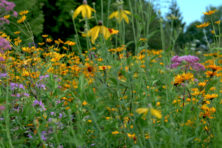Unsung Pollinators
- Share
- Tweet
- Pin
- Share

by Coggin Heeringa of Wild Ones of the Door Peninsula
In recent years, most folks have become aware of the importance of honey bees. Besides producing honey and wax, they pollinate many of the plants we use for food. Most of these crops came from Europe, but then, so did European honey bees.
So how were our native wildflowers pollinated before European honey bees were introduced into Wisconsin less than 200 years ago? Native insects pollinate native wildflowers.
Wild Ones of the Door Peninsula is an organization dedicated to promoting native plants in our landscapes, so we are also enthusiastic advocates of native pollinators.
Last summer, Wild Ones hosted a lecture by Heather Holm, a Minnesota researcher who specializes in wild bees. She explains in her book Bees: An Identification and Native Plant Forage Guide, “Virtually everywhere plants flower, [native] bees are present: sipping nectar, gathering pollen, constructing and provisioning nests. Bees are vegetarians that owe their entire existence to flowering plants, but it is certainly not a one-sided arrangement.
“Female bees collect protein-rich pollen as the principal ingredient of food caches that feed their developing offspring. While collecting the pollen, bees inadvertently shed small amounts of it, and not necessarily on the same flower where they acquire it.
“This redistribution of pollen from flower to flower is the greatest service bees provide to plants. Without pollination, the plants would not set fruit or seed, essentially halting the primary means of reproduction for many plant species.”
Hundreds of wild bee species are providing pollination services to wild plants. Furthermore, native bees also are unsung, but indispensable, pollinators in our gardens and orchards.
Wild bees are not the only unsung pollinators. Mosquitoes – yes. Mosquitoes are pollinators. So are syrphid and carrion flies. Butterflies, moths, beetles, gnats – all have species that are pollinators.
Flowers have evolved strategies to attract specific pollinators by offering “rewards.” Pollinators visit plants because they want nectar, pollen or both. The shape, color and scent of flowers are advertisements to entice pollinators. Many flowers have “nectar guides” – ultraviolet markings that are invisible to humans but show the pollinators where to find their reward.
Smells attract some pollinators. Flowers that are serviced by bees usually have sweet and pleasant (to humans) scents. Other flowers – skunk cabbage, wild ginger, Jack-in-the-pulpit – have a nasty or even dead-meat odor and attract flies, beetles and gnats.
We’re currently celebrating our “spring ephemerals”: the wildflowers that bloom in the forests before the trees’ leaves open and create shade. But different wildflowers bloom throughout the growing season, and this is essential. By staggering blooming dates, species do not have to compete for pollinators. Consequently, some source of nectar or pollen is always available from early spring to late fall.
And this is one of the many reasons why Wild Ones encourages people to plant native plants near their gardens and orchards: Pollinators need nectar and/or pollen throughout the growing season. While you wait for domestic flowers to bloom, your wildflowers will already be attracting pollinators.
Because of habitat loss, pesticide use and modern agricultural practices, native plants are in trouble, and by extension, so are native pollinators. Both need all the help we can give them.



